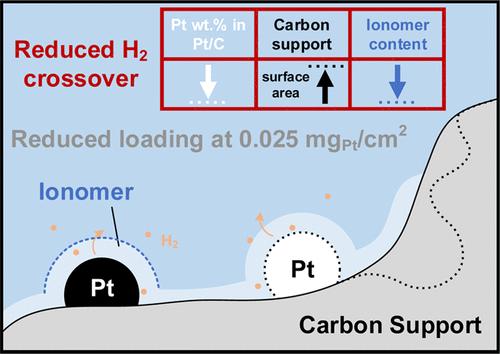当前位置:
X-MOL 学术
›
ACS Appl. Mater. Interfaces
›
论文详情
Our official English website, www.x-mol.net, welcomes your feedback! (Note: you will need to create a separate account there.)
Cathode Catalyst Layer Design in PEM Water Electrolysis toward Reduced Pt Loading and Hydrogen Crossover
ACS Applied Materials & Interfaces ( IF 9.5 ) Pub Date : 2024-04-23 , DOI: 10.1021/acsami.4c01827 Zheyu Zhang 1 , Axelle Baudy 1 , Andrea Testino 2, 3 , Lorenz Gubler 1
ACS Applied Materials & Interfaces ( IF 9.5 ) Pub Date : 2024-04-23 , DOI: 10.1021/acsami.4c01827 Zheyu Zhang 1 , Axelle Baudy 1 , Andrea Testino 2, 3 , Lorenz Gubler 1
Affiliation

|
Reducing the use of platinum group metals is crucial for the large-scale deployment of proton exchange membrane (PEM) water electrolysis systems. The optimization of the cathode catalyst layer and decrease of the cathode Pt loading are usually overlooked due to the predominant focus of research on the anode. However, given the close relationship between the rate of hydrogen permeation through the membrane in an operating cell and the local hydrogen concentration near the membrane–cathode interface, the structural design of the cathode catalyst layer is considered to be of pivotal importance for reducing H2 crossover, particularly in combination with the use of thin (≲50 μm) membranes. In this study, we have conducted a detailed investigation on the cathode structural parameters, covering the Pt wt % of the Pt/C electrocatalyst, the type of carbon support (Vulcan and high surface area carbon, HSAC), and the ionomer content, with a goal to reduce Pt loading to 0.025 mgPt/cm2 while minimizing the rate of cell hydrogen crossover. We found that the electrochemical performance is mainly influenced by the changes in the interfacial contact resistance due to variations in the cathode thickness. Both the Pt wt % in Pt/C and the ionomer content showed a positive correlation with the measured H2 in O2% in the anode outlet, whereas the Pt loading exhibited an opposite trend. The rate of hydrogen crossover was analyzed in relation to the calculated local volumetric current density within the cathode catalyst layer. Based on the obtained hydrogen mass transfer coefficient, a cathode catalyst layer comprising 40 wt % Pt on HSAC support with an ionomer-to-carbon (I/C) ratio of 0.35 was found to be an optimum configuration for achieving a low Pt loading of 0.025 mgPt/cm2 and a reduced rate of hydrogen crossover.
中文翻译:

PEM 水电解中的阴极催化剂层设计可减少 Pt 负载和氢交叉
减少铂族金属的使用对于大规模部署质子交换膜(PEM)水电解系统至关重要。由于研究主要集中在阳极,因此阴极催化剂层的优化和阴极 Pt 负载量的降低通常被忽视。然而,考虑到运行电池中氢透过膜的速率与膜-阴极界面附近的局部氢浓度之间的密切关系,阴极催化剂层的结构设计被认为对于减少H 2至关重要。交叉,特别是与薄(≲50μm)膜的使用相结合。在这项研究中,我们对阴极结构参数进行了详细的研究,包括 Pt/C 电催化剂的 Pt wt%、碳载体的类型(Vulcan 和高表面积碳,HSAC)以及离聚物含量,目标是将 Pt 负载量减少至 0.025 mg Pt /cm 2,同时最大限度地降低电池氢交叉率。我们发现电化学性能主要受到阴极厚度变化导致的界面接触电阻变化的影响。 Pt/C中的Pt重量%和离聚物含量均与阳极出口中测量的O 2 %中的H 2呈正相关,而Pt负载量则呈现相反的趋势。根据计算出的阴极催化剂层内的局部体积电流密度来分析氢穿透率。基于获得的氢传质系数,发现在 HSAC 载体上包含 40 wt% Pt 且离聚物与碳 (I/C) 比为 0.35 的阴极催化剂层是实现低 Pt 负载量的最佳配置。 0.025 mg Pt /cm 2和降低的氢穿透率。
更新日期:2024-04-26
中文翻译:

PEM 水电解中的阴极催化剂层设计可减少 Pt 负载和氢交叉
减少铂族金属的使用对于大规模部署质子交换膜(PEM)水电解系统至关重要。由于研究主要集中在阳极,因此阴极催化剂层的优化和阴极 Pt 负载量的降低通常被忽视。然而,考虑到运行电池中氢透过膜的速率与膜-阴极界面附近的局部氢浓度之间的密切关系,阴极催化剂层的结构设计被认为对于减少H 2至关重要。交叉,特别是与薄(≲50μm)膜的使用相结合。在这项研究中,我们对阴极结构参数进行了详细的研究,包括 Pt/C 电催化剂的 Pt wt%、碳载体的类型(Vulcan 和高表面积碳,HSAC)以及离聚物含量,目标是将 Pt 负载量减少至 0.025 mg Pt /cm 2,同时最大限度地降低电池氢交叉率。我们发现电化学性能主要受到阴极厚度变化导致的界面接触电阻变化的影响。 Pt/C中的Pt重量%和离聚物含量均与阳极出口中测量的O 2 %中的H 2呈正相关,而Pt负载量则呈现相反的趋势。根据计算出的阴极催化剂层内的局部体积电流密度来分析氢穿透率。基于获得的氢传质系数,发现在 HSAC 载体上包含 40 wt% Pt 且离聚物与碳 (I/C) 比为 0.35 的阴极催化剂层是实现低 Pt 负载量的最佳配置。 0.025 mg Pt /cm 2和降低的氢穿透率。



























 京公网安备 11010802027423号
京公网安备 11010802027423号